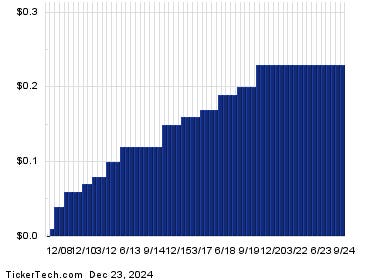2024 by any measure has been an extremely rewarding year for U.S. stock investors. Also, it has been a year dominated with big investment themes including Artificial Intelligence (AI), the growing demand for electrical power in the U.S., the reassertion of Bitcoin and Crypto, the increasing usage of GLP-1 drugs and the rebuilding of U.S. infrastructure. As the year comes to an end, we want to look ahead to some of the possible major investment themes for 2025. These themes are from the research work by William O’Neil + Co.’s experienced equity analysts. Some of the themes are new and others are continuations of trends we saw in 2024.
Themes:
1) Artificial Intelligence (AIQ)
- Software – Revenue from generative AI is expected to expand at a 10-year CAGR of 46% and reach $1.6T by 2032. However, Software generative AI will grow even faster, at a 10-year CAGR of 84%, and account for 49% ($797B) of that total ($1.6T). Among widespread impacts across sectors, Generative AI will have a significant impact on the following software sub-segments: Enterprise Productivity (CRM, HUBS, TEAM), Cybersecurity (PANW, CRWD), Data Analytics (SNOW, PLTR) Software Infrastructure Monitoring (DDOG, NTNX, NET) Advertisements/Search (APP, TTD) and IT Services (GTLB)).
- Hardware/Semis – The AI Arms Race – Hyperscalers like Alphabet, Amazon, Microsoft, Oracle, and Meta are spending heavily, and in some cases aggressively, in their datacenter infrastructure to capitalize on the AI trend. No one wants to be left behind in this race. According to estimates from various sources, 2024 capex for hyperscalers is expected to grow 47% in 2024 and reach $270B in 2025, up 24% y/y. These high and rising capex figures are opening large growth opportunities for providers of chips and networking products that power AI infrastructure. The biggest beneficiaries in our view include those with higher AI-related exposure versus peers: Nvidia (NVDA), Broadcom (AVGO), Taiwan Semiconductor (TSM), Arista Networks (ANET), Marvell Technology (MRVL), ARM (ARM), Lumentum (LITE), Coherent (COHR), and Astera Labs (ALAB).
2) Industrials: AI-Driven Demand for Data Center Infrastructure (DTCR)
- The data center physical infrastructure market is expected to grow at a ~11.5% CAGR through 2029. AI data centers need 3x more power than a normal data center, driving the demand for power management products such as switchgear and transformers. Due to the heavy compute loads of AI data centers, data center operators are exploring liquid cooling, which uses water or other fluids to cool high-density racks. Liquid cooling can be 3,000 times more efficient than air cooling. It is an emerging tech and does not have mainstream adoption yet but is expected pickup in FY25. The global liquid cooling market is projected to grow to $12.8B in 2029 from $4.5B in 2024 at a CAGR of 23%.
Key Stocks:
- Cooling Systems: VRT, FIX, NVT, MOD, AAON, TT, [email protected]
- Power Management Products: VRT, ETN, [email protected], ABBN.CH
3) Energy – Rising Electricity Demand, Nuclear/Gas Demand to power Data Centers (RBLD)
- The forecast of cumulative electricity growth in the U.S. over the next five years has shot up from 2.8% to 15.8%. In 2024, the data centers accounted for 3.5% of U.S. electricity consumption. This is expected to increase to 9%+ by 2030 driven by the growth in generative AI. Upward-revised electricity growth forecast would mean a ramp up of planning and construction of new generation and transmission capacity by a factor of six. This should drive growth for engineering, procurement, and construction companies, providers of transformers and other grid/transmission products.
- Electrical Equipment Companies: [email protected], ETN, ABBN.CH, GEV, HUBB, POWL.
- Power Generation and T&D Infrastructure Companies: PWR, EME, PRIM, AGX.
- The increase in new generation capacity will likely need come from a mix of several sources, but natural gas and nuclear are the two best positioned now.
- Per EQT Corporation, U.S. gas-fired power plant demand increased by ~14 billion cubic feet per day (Bcf/d) from 2010 to 2024, primarily driven by coal-to-gas switching with minimal load growth. Post 2024, demand is expected to accelerate due to AI/data centers, EV adoption, and ongoing coal phase-outs. This is projected to add ~10 Bcf/d of incremental natural gas demand by 2030, with upside potential of up to ~18 Bcf/d in aggressive data center growth scenarios.
- Also, the U.S. Department of Energy estimates nuclear capacity could triple in an aggressive scenario by 2050, driven by increases at existing plants and new/advanced reactors.
- MSFT’s deal with Constellation to restart Three-Mile Island and provide nuclear power for 20 years (800MW) … also GOOGL’s agreement with Kairos Power to deploy a fleet of small advanced nuclear power projects (500MW in total beginning in ~2030). Highlighting the growing pushback into nuclear, OKLO and data center operator Switch are targeting 12GW of nuclear power by 2044 (small scale plants).
- Stocks of interest: GEV, CEG, VST, NRG, TLN, BWXT, AROC, KGS, CNX, TRGP, and GPOR.
4) Consumer – Selective Shoppers (PEJ)
While inflation is easing, prices remain well above pre-pandemic levels and are likely to stay high or even increase under a potential second Trump Administration. As a result, U.S. shoppers are expected to maintain a selective spending approach focusing on purchases when they find the right products at reasonable prices. This selective spending behavior has created a clear divide between winners and losers in the consumer and retail space. Brands that resonate strongly with households earning over $100,000 continue to thrive. For instance, 75% of Walmart’s market share gains last quarter came from households earning more than $100,000, contributing significantly to Walmart’s stock performance in 2024. Other brands like Carvana, Cava, Sweetgreen, Sprouts, Warby Parker, On Holding, Royal Caribbean, and SharkNinja have emerged as leaders in their respective categories. Conversely, brands targeting lower-income consumers, such as Dollar Tree, Dollar General, and Savers, have struggled. Similarly, brands like Nike and Lululemon, which have failed to captivate consumers due to a lack of innovation, have also lagged.
- In 2025, this trend is expected to accelerate, driven by continued inflationary pressures from tariffs and a strong dollar. Key themes expected to shape the U.S. consumer landscape in 2025 include:
- Health and Wellness: Consumers are increasingly prioritizing health, driving demand for products that support well-being. This includes functional beverages aimed at hydration, anti-aging, gut health, and cognitive enhancement. The trend also reflects a preference for high-protein foods across all meals, highlighting a proactive approach to health. Stocks of interest: COCO, ELF, PG, BRBR, PBH, KVUE, PLNT, SG, CAVA, SFM, and WMT.
- Innovation and Technology Integration: Consumers today expect more personalized interactions, and innovation in data analytics and AI is key. Also, consumer trends are rapidly shifting, and companies that innovate are best positioned to adapt. Stocks of Interest: ODD, DECK, ONON, AS, SN, CVNA, DASH, and WRBY.
- Experience-Driven Consumption: There is a growing shift towards valuing experiences over material possessions, with consumers investing more in travel, live events, and other meaningful activities. Stocks of Interests: RCL, VIK, BKNG, EXPE, OSW, FLUT, EAT, TXRH, and BROS.
5) Internet – Video Ad Monetization (PNQI)
Over the past two years, video streamers have introduced ad-supported tiers to capitalize on the shift in viewership and align with the growing migration of ad dollars to their platforms. As these platforms begin to scale in 2025, they are set to capture a larger share of ad spend. In 2019, linear TV captured 75% of U.S. video ad spend, with digital (including CTV) at 25%. By 2027, digital video ad spending is expected to surpass linear TV, presenting a $50B opportunity for CTV streaming to capitalize on linear TV’s decline. Additionally, the shifting of live sports rights to streaming will accelerate ad dollar migration. Among streamers, Netflix (NFLX), the only profitable pure-play platform, is a major beneficiary of cord cutting. Its advertising expansion emphasizes profitability over subscriber growth. Competitors like Disney (DIS), Warner Bros Discovery (WBD), and Paramount (PARA) are also prioritizing streaming profitability alongside subscriber growth. Pure-play digital video (e.g., social and short-form video) represents 8% of the ad market, with an 18% CAGR since 2019. It is projected to grow at a high-single-digit CAGR through 2028, benefiting platforms like Meta’s Reels (META) and Alphabet’s YouTube Shorts (GOOGL). Spotify’s (SPOT) venture into video is also noteworthy. Programmatic ad players like The Trade Desk (TTD) and Magnite (MGNI) will benefit from increased video ad inventory across the digital and CTV landscape.
In conclusion, while 2024 was an exciting and profitable year, William O’Neil + Co. believes 2025 can be as well. As such, we want to identify both themes from last year that can continue to perform in the new year as well as newly emerging themes that have a chance to produce large returns. This list curated by the William O’Neil analysts provides a good starting point for investors to consider.
Kenley Scott, Director, Global Sector Strategist at William O’Neil + Co., made significant contributions to the data compilation, analysis, and writing for this article.
The William O’Neil + Co. Research Analysts made significant contributions to the data compilation, analysis, and writing for this article.
Disclaimer
No part of the authors’ compensation was, is, or will be directly or indirectly related to the specific recommendations or views expressed herein. William O’Neil + Co., its affiliates, and/or their respective officers, directors, or employees may have interests, or long or short positions, and may at any time make purchases or sales as a principal or agent of the securities referred to herein.
William O’Neil + Co. Incorporated is an SEC Registered Investment Adviser. Employees of William O’Neil + Company and its affiliates may now or in the future have positions in securities mentioned in this communication. Our content should not be relied upon as the sole factor in determining whether to buy, sell, or hold a stock. For important information about reports, our business, and legal notices please go to www.williamoneil.com/legal.
©2024, William O’Neil + Company, Inc. All Rights Reserved.
Read the full article here
















